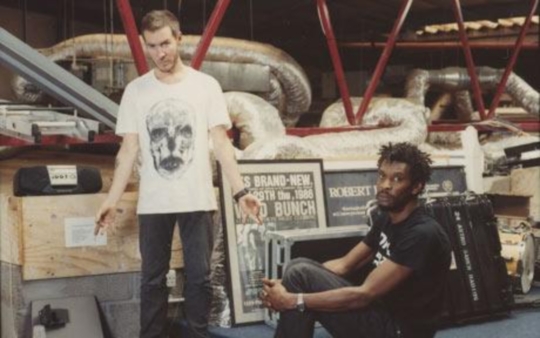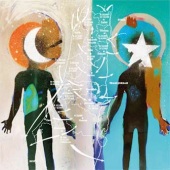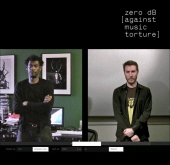The Beat Goes On (Telegraph, 8th July 2010)
As Massive Attack prepare to headline the Big Chill festival, Robert Del Naja and Grant Marshall look back on 25 influential years

In August, in the grounds of a Herefordshire castle, down by the arboretum, past the ornamental lake, there will be a gathering of the clans, the bucolic AGM for a generation.
For two reasons its title is significant. The Big Chill festival is named after a film, Lawrence Kasdan’s wistful tale of a reunion of Californians 20 years on from their bohemian glory days as children of the 1960s. In 1983 it made stars of Glenn Close, William Hurt and Jeff Goldbum, and in turn made an indelible impression on the children of the 1980s.
But for those viewers the word chill had another meaning, one unique to their own era.
Adopted from the lexicon of hip-hop, in the late 1980s and 90s 'chill’ became a verb with a voracious reach. In 1985 Run DMC were saying it; by 1995 my mum was saying it. Love it or hate it, chilling was what everyone was doing, and yet chilling was the opposite of doing. It was the verb for the morning after the night before.
And where Kasdan’s Big Chill played out to a soundtrack provided by the Beach Boys, among others, the big chill of late-80s Britain had a score from its own west coast – the laidback music of Bristol and the group that will top the bill by the lake next month, the pioneering Massive Attack.
It was on the hills of Bristol that I first learnt about the ups and downs of life. I studied there in the late 1980s, three years of steep climbs and sharp descents, learning that often it can be harder to come down than go up. I learnt through endless drizzle that there is one 's’ too many in 'West Country’, but that no one there lets it dampen the spirits. Most of all I learnt how to have a good time, and that to have a good time you really need good music.
The club to go to was called the Dug Out. Up near the university in the least-posh end of posh Clifton, it was a sticky-carpeted meeting place for a truly bizarre clientele. On to one wall in the top room clips from classic films were projected, along with an inspirational roster of new and vintage pop videos – the Clash, the Cure, and Run DMC. The other walls were thick with spray-can art, graffiti, stylised urban images – the Bronx imagined through Bristolian eyes.
Downstairs the tiny dancefloor reverberated to a kind of deejayed free-for-all in which punk, ska, new romantic, soul, country, reggae, disco and hip-hop collided, no one seeming to bother if you could dance to it or not. Here students called Whystan and Lucinda bumped along with cidery Bristol break-dancers called Dee and Aitch, middle-aged hippies from Frome called Faye and whiskery rasta-men called Oval and Barrington.
I had never come across anything like it before – the hurling together of white and black music, white and black people, cinema and art. But this claustrophobic shebeen gave birth to an aesthetic that encompassed musical acts as diverse as Tricky, Portishead and Goldfrapp, and the satirical street art of Banksy, and spread not only across Britain but around the world.
The group that did most to spread it were Massive Attack. I can’t say for sure whether I ever bummed a cigarette off Robert Del Naja in the Dug Out, or spilled my Taunton Special Vat on the shoes of his Massive Attack co-founder Grant Marshall, although I wouldn’t be surprised. But a few weeks ago, nearly 25 years on, I took the train back to the West Country, to talk to them about Heligoland, the album they released in March, their first for 10 years.
As I walked out of Temple Meads station I was struck by a sheet of rain that felt as if it had been slung from a bucket. The band’s studio is on an anonymous light-industrial estate in the Bedminster part of town. Arriving at a front door made of bright-yellow mirrored glass, before I press the buzzer I lean closer to adjust my bedraggled clothes. With my nose just an inch away from it, the door is suddenly pulled open and the huge, smiling figure of the 6ft 6in Marshall is before me. 'Oroight, boy?’ he cackles. 'When you’ve finished poncin’ up your hair, you better come in.’
Though their music and indeed their image has a serious and sometimes heavy air about it, Massive Attack began in 1988 as a bit of a laugh. There were originally three members: Del Naja, Marshall and Andrew Vowles. They had sprung from a collective known as the Wild Bunch, a gaggle of black and white rappers and DJs who ran a sound system, playing regularly at the Dug Out and putting on events in disused buildings. Film fanatics as much as music aficionados, they named themselves after Sam Peckinpah’s ultra-tough cowboy film of 1969. The Wild Bunch had bags of cool, but what earned them their reputation was the fun they could fill a room with: they were about good times.
'From the very first days putting on parties and selling a few beers out the back of a car,’ Marshall says, 'it was all about putting together two elements in the records we played that were completely opposite: the rough and the smooth, a reggae record with a punk record. And we carried that same ethos later with our own music.’ Born in Bristol in 1959 to working-class West Indian parents, Marshall has been a DJ since his teens, and that has remained his primary role in the group. For most men of 50, the DJ uniform of jeans and slogan T-shirt smacks of mutton dressed as lamb, but Marshall carries it with considerable verve.
'Our record collections were very male,’ Del Naja says. 'But we began to introduce women’s voices into the equation and made it less macho – it was just a good party, a good mix of the sexes. From that came the first Wild Bunch record, a crusty beat with a sweet song on top of it.’ In 1985 the Wild Bunch released The Look of Love, a cover of the Burt Bacharach song made famous by Dusty Springfield in 1967 and this time made up of computer loops and the dreamy vocals of another female singer, Shara Nelson. 'The aperture was open to see things a different way,’ Del Naja says. 'We had never brought in people from outside our little gang before. Then suddenly we went, ah, yes that’s a bit different. Even in those days I was always thinking, where can we go next with this?’
Del Naja, who was born in 1966, comes from an Anglo-Neapolitan family, and started out as a graffiti artist. His first ever performance was DJing to accompany a show of his paintings in Bristol. He sports a leather coat during our interview, and has an intense air about him that is at once charming and combative.
Each of the three who set up Massive Attack pushed the group in a different direction: Marshall, reggae; Vowles, hip-hop; Del Naja, punk. And if the revolutionary idea of punk a decade earlier was that you didn’t need to be able to play your instruments to form a band, what Massive Attack did was to say that you didn’t need instruments at all. Del Naja recalls his first encounter with a sampler, the piece of technology that was to become the engine of pop music for the next 10 years: 'We just couldn’t wait to get our hands on it. The punk scene was dying and this was the thing that gave us the opportunity to turn what we liked as music-listeners into something new.’
But Massive Attack didn’t do with their sampler what legions up and down the country were doing. From North to South, Britain at this time was in the grip of acid house, but what emanates from Bristol comes from left-field. 'The first thing we did was to slow the tempo down by half,’ Del Naja says. 'It was the weirdest thing, but it felt natural to us. That was how we started making music. And it still applies – every time we have a record out there seems to be a contraflow going in a different speed and direction to us.’
By 1991 millions of Britons were staying up all night every weekend dancing to uptempo, celebratory house music. But for every night up, there came two, three days down – more even. And into that environment Massive Attack released their album Blue Lines, one of the most influential debuts by a British group. Taking the 'crusty beat with a sweet vocal on top’ to its logical conclusion, it was stately and soulful, with a brooding, moody quality. Blue Lines looked beyond the dance, seeming to reflect not crowds and the shared experience but an introspective, even isolated world.
'With music,’ Del Naja says, 'I find it’s in my own head. In the studio, even at gigs now, it’s an internalised experience. I was different when I was a kid, and it was more of a communal, football-match experience: singing along, jumping up and down. But as I’ve got older I find more and more it becomes something inside me, like a trance – and it’s great. It may be glib, but I think Grant’s musical world is different because he is a DJ – he’s used to facing the audience, watching the dancefloor.’
The relationship between the two men is a long and complex one. In conversation Del Naja, who is 44, leans inwards, is intent and discursive; Marshall leans away, at times drifts away, but then interjects with something sharp, or reaches a long arm over, the better to jab a finger. At one point he begins to tell me what sums up Massive Attack to him.
'Feller came up to me after one show and says, “My son…”’
'Not that anecdote again,’ Del Naja says. 'I have to sit through this every time.’
'I gotta shoehorn it in somewhere! Feller says, “My son, right, was made to Massive Attack.” You know – conceived. We got a new generation of fans coming through.’
I ask Marshall if after 30 years in music and with two children he ever tires of the pop life.
'Tire of the pop life? I wanna carry on. As far as we’re concerned we’re blagging it and having a great time.’
'As far as he’s concerned, he’s blagging it,’ Del Naja says.
'That’s why we said no to The South Bank Show for however many years in a row,’ Marshall says. 'No way, you’re gonna give us away, expose us. No one’ll ever take us seriously again.’
All of this is conducted with warmth and humour, but that has not always been the way. The group has fought and come unglued on a number of occasions, and there is no doubt that Del Naja is the dominant personality, the creative driver.
In the making of the second album, Protection (1993), relations with the third original member, Andrew Vowles, were becoming strained and he left the band after the third and biggest-selling album, Mezzanine (1998).
The band’s signature has been the collaboration with guest vocalists, from Tracey Thorn to Horace Andy, Guy Garvey to Damon Albarn, and that can be a testing process. 'In the studio there are a lot of days with no ideas, a lot of rows with different people, negative times with things not working,’ Del Naja says. 'And that’s what life is like.’ He doesn’t elaborate on who does the rowing, but there was a period in the late 1990s when the group could tolerate doing interviews only separately. 'Then on tour, you’ve done the work, all the ideas have gone into the light show, the visuals, you’ve rehearsed and you’re just enjoying being there,’ Del Naja says.
For the band with no instruments to become a live propositon was another difficult evolution, but one that played to Del Naja’s strengths. The group’s visual presence has always been his domain, and today their stage show is in effect an art installation that makes use of LED systems to display data that reflect his political beliefs. It’s a way of performing they have been developing since the turn of the millennium. The group made strong efforts to mobilise musicians to protest against the Iraq war, even taking out full-page adverts in the NME. Though in this they did not seem to chime with the times, finding that most of their fellow musicians were too apathetic – indeed chilled – to care.
'It’s an expensive hobby,’ Del Naja says of the touring set-up. 'We translate stuff from the local press wherever we are. In Madrid, Barcelona, San Sebastián we’d arrive and get to work with local students. It was manic, translating into Spanish, Catalan and Basque, trying to get the right slang.’ The words and images are dazzling, relentless: statistics about capitalism, Gaza, man’s despoiling of nature. The effect is mixed. On the one hand, great – no one else is doing this, my generation’s political apathy is a disgrace; but then also, do shut up with your lecturing and play us the famous ones.
Around 2001 relations between Del Naja and Marshall over the direction of the band became unworkable and the latter had nothing to do with the fourth album, 100th Window, essentially a Del Naja solo record. Yet without Marshall’s sheer presence, his humour and his DJ’s feel for what pleases a crowd, Massive Attack lacked the sense of collective endeavour that had been the key to their success. But a sabbatical to devote time to fatherhood seems to have brought about a rapprochement. Marshall’s return has made this year’s Heligoland a set of songs worthy of comparison with the golden triptych the group produced from 1991-98.
We talk about the era when I was in Bristol too. It was a laugh, I say. 'Were you laughing with us or at us?’ Del Naja asks, only sort of joking. 'We can be serious. Music is one form of expression and having a laugh is another. But you can’t take anything seriously unless you can laugh about it, and vice-versa. We tend to gravitate to the serious when we’re working.
'Some people get removed from the art form they first fell in love with, but I find it catches me even more. It’s like a spell. When I look at the audience, I see a lot of people with their eyes closed, nodding, in their own space. Each person doing their own little dance, lost in their thoughts, searching for what they find in it. And that’s the way our music is made.’
The Bristol sound has touched a lot of people, the people who will lounge in the arboretum next month as Marshall and Del Naja play, the generation for whom hedonism became not the activity of a subversive few but the mainstream, the middle-class way of life. The Wild Bunch livelied up more than one party for the student Sarah Brown; Samantha Cameron used to shoot pool at a cafe called Special K with Tricky, another Massive associate. I remember hearing one bumptious Old Etonian who had been to Bristol shout out 'Sounds of the Massive!’ – the final words on Blue Lines – and being staggered that a Venn diagram could be drawn between the sound systems of ghetto Britain and people whose dads were in Debrett’s.
But for all the reach and resonance of their music, I left Bristol buoyed most of all by the sense that somehow they were still just a pair of West Country chancers taking the mickey – out of me, out of the music business, out of life. Are you rich, I asked at one point. 'We’ve had a bar down here for 10 years,’ Marshall said. 'It’s lost us millions.’ Who looks after it? 'We have no idea. It’s been closed for six months, soon as we went on tour. That’s Bristol – everyone takes the piss!’ And I can tell you, seriously, they do.
Massive Attack headline the Big Chill on August 5. A deluxe limited-edition vinyl box set of Heligoland, including a book of Robert Del Naja’s art, will be released on Vinyl Factory in September
By Tom Horan
http://www.telegraph.co.uk/culture/music/7876770/Massive-Attack-the-beat-goes-on.html








